When diving into Norse mythology, there are few names as iconic and evocative as Thor. Revered for his strength, valor, and the booming thunder that heralded his presence, Thor has captivated the imagination of countless generations.
Thor Key Facts
| Parents | Odin and Jord (Earth) |
| Partners | Sif, Järnsaxa |
| Siblings | Baldur, Víðarr, Váli, and others |
| Offspring | Magni, Modi, and Thrud |
| Tribe | Aesir |
| Old Norse name | Þórr |
| Other names | Asa-Thor, Oku-Thor |
| The God of | Thunder, Lightning, Protection |
| Ass. Animal | Goat (Tanngrisnir and Tanngnjóstr) |
Name and Etymology
Thor, or Þórr in Old Norse, traces its origins to an older poetic form, Þunarr. This name, over time, evolved from the Proto-Norse form reconstructed as Þunraʀ. From this root, we see a fascinating convergence in various Germanic languages: Donar in Old High German, Þunor in Old English, Thuner in Old Frisian, and Thunar in Old Saxon. All these names share a common ancestry in the Proto-Germanic reconstructed theonym *Þun(a)raz, which translates to ‘Thunder’.
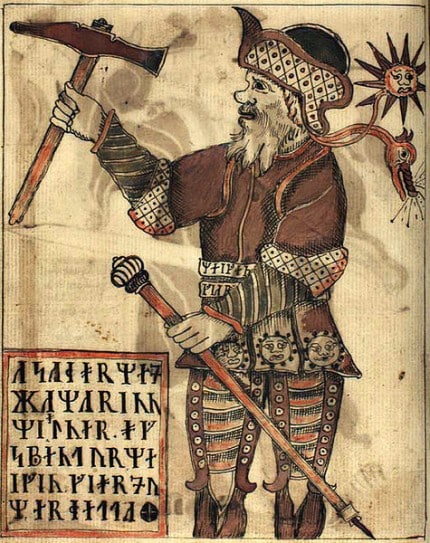
This linguistic exploration reveals the deep-seated reverence for the thunder god across various cultures and eras. Even the English weekday name, Thursday, offers a nod to Thor. Stemming from Old English Þunresdæg, it means ‘day of Þunor’. This etymology is consistent with Old Norse’s Þórsdagr and Old High German’s Donarestag, both of which are derived from the Late Proto-Germanic weekday *Þonaresdag, signifying the ‘Day of *Þun(a)raz’.
Thor remains a popular boy name in Nordic countries even today. Given how important Thor was in Norse mythology, this popularity is hardly surprising.
Ancient roots
Diving deeper into linguistic roots, scholar Peter Jackson proposes a connection between these theonyms and a Proto-Indo-European thunder-god, *Perkwunos. This link is evident in the epithet (or epiclesis, an invocational name) of the Vedic weather-god, Parjanya, who was also referred to as stanayitnú-, which translates to ‘Thunderer’. The enduring legacy of this ancient deity is remarkable, showcasing how cultural narratives, though varying in details, often stem from shared primordial concepts.
The origins of Thor’s name and role hold an even broader historical and cultural significance. The linguistic connection between Thor and the Vedic weather-god, Parjanya, shines a light on shared archetypes within Indo-European cultures. Parjanya, like Thor, was a powerful deity associated with thunder and rain, playing a crucial role in agricultural societies where weather dictated the success or failure of crops. This shared emphasis on a thunder deity hints at possible ancient cultural exchanges or shared mythological roots stretching back millennia.
Kennings from Skáldskaparmál
In the Skáldskaparmál, an ancient text that offers insights into poetic expressions and metaphors, Thor is described through a series of kennings, which are poetic circumlocutions. Here are some of the kennings for Thor:
- Son of Odin and of Jörd
- Father of Magni, Módi, and Thrúdr
- Husband of Sif
- Stepfather of Ullr
- Wielder and Possessor of Mjöllnir, the Girdle of Strength, and Bilskirnir
- Defender of Ásgard and Midgard
- Adversary and Slayer of Giants and Troll-Women
- Smiter of Hrungnir, Geirrödr, and Thrívaldi
- Master of Thjálfi and Röskva
- Foe of the Midgard Serpent
- Foster-father of Vingnir and Hlóra.
These kennings, while ornate, provide a holistic view of Thor’s role, relationships, and deeds, encapsulating the might and reverence associated with him in the Norse world.
Thor’s Origins: A Blend of Aesir and Jötun Blood
The intermingling of divine and giant ancestries is a recurring theme in Norse mythology, creating a complex tapestry of relationships and loyalties. Such mixed heritage often lends depth and ambiguity to the characters, enriching their stories and highlighting the intricate nature of the mythological universe.
The Intricacy of Aesir Lineages
Thor’s lineage stands as a prime example of this intricate blend. He shares a significant portion of Jötun blood, a fact that contrasts starkly with his identity as one of the mightiest Aesir gods. His father Odin, the Allfather and chief of the Aesir, himself has Jötun roots. His mother, Bestla, belonged to the Jötun race, making Odin half-jötun. Such a lineage provides a unique perspective into Odin’s own endeavors and interactions with various realms and beings, particularly the Jötun.
Thor’s Jötun ancestry is even more pronounced. His mother, Järnsaxa, is a Jötun, which means Thor is actually three-quarters Jötun. This duality becomes especially poignant considering he frequently confronts giants and stands as Asgard’s defender against their threats. This is even though he shares more lineage with them than with his fellow Aesir gods.
Yet, this kind of mixed heritage is not unique to Thor. Many Aesir gods have backgrounds interwoven with the Jötun, underscoring the blurred lines between the two races. The Aesir and the Jötun, despite their frequent clashes, are deeply interconnected, both in lineage and destiny. This interplay between races reinforces the idea that identity in Norse mythology extends beyond mere ancestry—it is also shaped by choices, actions, and allegiances.
Brothers of Thor
- Baldur: Revered and cherished, Baldur epitomizes light, purity, and beauty. As the god of these virtues, he occupies a special place in the pantheon.
- Bragi: Embellishing the halls of Asgard with his poetic prowess, Bragi is the god of poetry, eloquence, and music, narrating tales of valor, love, and mythic grandeur.
- Heimdall: Keeping a vigilant watch over the Bifröst bridge, Heimdall, with his heightened senses, ensures the security of the gods’ realm as their watchman.
- Hermod: As the gods’ messenger, Hermod is renowned for his daring voyage to Hel, the underworld, in a bid to rescue his brother, Baldur.
- Hodr: Despite being the god of darkness and winter, Hodr’s reputation is overshadowed by the tragic accident where he, unknowingly, caused Baldur’s death.
- Meili: A lesser-known figure, Meili stands as a symbol for travel or exploration, subtly reminding us of the vastness of the Norse world and the realms beyond.
- Tyr: Symbolizing war and justice, Tyr’s bravery shines brightest in the tale of the binding of Fenrir, the monstrous wolf, where he sacrificed his hand for the greater good.
- Vali: Born with a singular purpose, Vali’s life mission was to avenge Baldur’s death, marking him as a symbol of swift justice.
- Vidarr: Mysterious and silent, Vidarr’s association with revenge is profound, and prophecies suggest he will outlive Ragnarok, the end of the world.
This illustrious list of Thor’s brothers paints a vivid picture of the Aesir family’s diverse roles, strengths, and tales, each contributing to the intricate mosaic of Norse mythology.
Thor Family and Relationships
When it comes to Norse gods, their familial ties and relationships often serve as the backbone for many myths, defining their personalities, motives, and actions. Thor, with his thunderous presence, is no exception. His relationships are marked by love, duty, passion, and sometimes, conflict. Delving into his ties with significant others and his progeny provides us with a more rounded understanding of the god beyond his battle exploits.
Sif
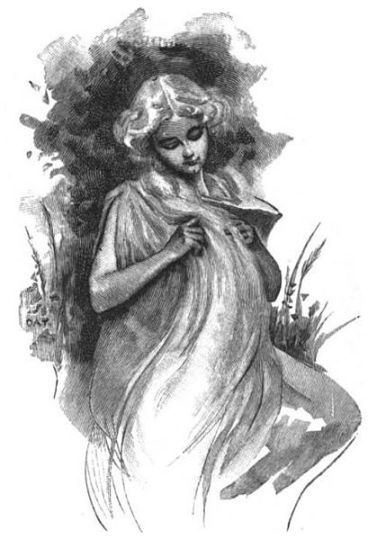
Sif, Thor’s wife, is emblematic of the bond between strength and beauty. Often recognized for her glorious golden hair, she is a goddess of fertility and family. Her radiant locks, once maliciously cut off by Loki, became the center of a tale where Loki had to restore them using dwarven magic, resulting in her hair becoming even more enchanting. Thor and Sif’s marriage, by most accounts, appears harmonious. Their bond represents a union of might and elegance, where Sif’s gentleness complements Thor’s boisterous nature.
While there are many tales highlighting Thor’s strength, there are just as many where Sif’s wisdom and grace play crucial roles. Their partnership is a testament to the multifaceted nature of relationships in the Norse cosmos – where both power and beauty are revered and vital.
Järnsaxa
Järnsaxa, a giantess from Jotunheim, stands out as one of Thor’s most intriguing relationships. Her name, which translates to “Iron-cutting axe” or “Iron-sword,” indicates her fierce nature and formidable presence. While Sif was Thor’s official consort, Norse myths hint at a dalliance between Thor and Järnsaxa, making their relationship one of passion and intensity. Such relationships between gods and giants were not uncommon, representing the complex and often intertwined fates of the two realms.
Järnsaxa bore Thor a son, Magni, who as mentioned earlier, showcased remarkable strength from a very young age. Their relationship, although not deeply explored in myths, is an important facet of Thor’s life, illustrating his connections outside the confines of Asgard and his ability to form bonds even with those deemed adversaries of the Aesir.
Children
Magni and Modi
Magni and Modi are two of Thor’s most notable offspring, and they inherit their father’s valor and might. Magni, whose name means “Strength,” once aided his father by lifting the immense weight of the fallen giant Hrungnir off Thor, showcasing a might that surpassed even the gods when he was merely three nights old. Modi, translating to “Courage,” embodies bravery and fierce determination, traits unmistakably passed down from Thor.
Both Magni and Modi are foretold to inherit their father’s hammer, Mjölnir, after Ragnarok, the end of days. This not only indicates their significant roles in the post-apocalyptic world but also underscores the importance of lineage in Norse myths. Their future task of defending the new world mirrors Thor’s role, perpetuating his legacy.
Thrúdr
Thrúdr, Thor’s daughter, is another fascinating figure. While not as frequently mentioned as her brothers, she embodies the spirit of strength and resilience, true to her lineage. Her name, meaning “Strength,” echoes the power that runs in the family. The myths, though sparse on her tales, suggest that she possessed a demeanor befitting the offspring of the thunder god.
One of the few tales where Thrúdr prominently features is her intended marriage to the dwarf Alvíss, a union Thor opposed. Determined to prevent the match, Thor challenged Alvíss to a contest of wits, which lasted until dawn. As the first light of day touched the dwarf, he turned to stone, and Thrúdr remained in Asgard. Through this tale, we see Thor’s protective nature, ensuring his daughter’s well-being.
Ullr
Ullr, often associated with Thor, is commonly recognized as his stepson. While not Thor’s biological child, Ullr’s relationship with the thunder god is emblematic of the blended family structures prominent in Norse mythology. Renowned as the god of winter, hunting, and archery, Ullr’s skills with a bow and on skis are legendary. Many believe that he ruled over Asgard during Odin’s occasional absences, suggesting his significant stature among the gods.
The tales suggest a cordial relationship between Thor and Ullr. As Thor’s stepson, Ullr possibly benefited from Thor’s mentorship, inheriting not just skills but also values and principles that the Aesir held dear. Their bond underscores the importance of family, not just by blood but also by ties forged through trust, respect, and shared experiences.
Thor’s Role and Responsibilities
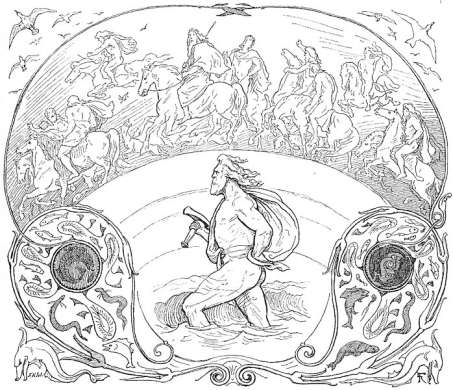
Thor’s legendary status is built upon a foundation of his immense power, unwavering courage, and an ironclad sense of duty. Often described as the protector and guardian of both gods and humans, he plays a pivotal role in maintaining balance in the cosmos. The dual nature of his responsibilities, as both a defender of gods and mankind, reveals a multi-dimensional character whose influence transcends the boundaries of realms.
Champion of the Aesir and Bane of the Jötun
Primarily, Thor is revered as the guardian of the Aesir gods. His role in defending Asgard, the fortress of the gods, from the advances and threats of the giants or Jötun, is legendary. Numerous myths recount his battles against these colossal beings, often stemming from their challenges to the supremacy or honor of the Aesir. In these tales, Thor is frequently seen wielding Mjölnir, his enchanted hammer, which became synonymous with his identity. Beyond the physical confrontations, Thor’s skirmishes with the mischievous Loki stand out. While Loki is not always an adversary, Thor’s interactions with him, ranging from camaraderie to confrontations, highlight the god’s unyielding commitment to justice and righteousness.
Furthermore, Thor’s unmatched physical strength and valiant spirit made him the quintessential warrior, embodying the very qualities that human fighters aspired to. His battles with the Jötun were not mere showcases of might but rather symbolic affirmations of the Aesir’s dominance and the cosmic order they upheld.
Defender of Midgard and Humanity’s Champion
Thor’s protective aura also extended to Midgard, the realm of mortals. His frequent interventions on their behalf, either against external threats like the Jötun or in internal human conflicts, underscore his dedication to safeguarding humanity. It was not just the gods of Asgard who revered Thor; even humans looked upon him as their champion. This belief was deeply ingrained in Viking culture, evident from the numerous Mjölnir hammer pendants discovered from that era, symbolizing his role as their protector.
Moreover, during the Viking age, there was a noticeable uptick in the naming convention, drawing inspiration from Thor. His influence was so pervasive that both boys and girls were named in his honor, indicating the widespread admiration and reverence he commanded.
The dual responsibilities that Thor shouldered, defending both Asgard and Midgard, emphasizes his indispensable role in Norse mythology. It wasn’t just his strength or valor but also his unwavering commitment to duty that earned him the adoration of both gods and men.
Thor’s Symbols, Artifacts, and Animals
When one imagines Thor, the thunder god from Norse mythology, a number of iconic images might spring to mind. His powerful presence is often accompanied by a set of unique symbols, artifacts, and animals that played crucial roles in his tales, adventures, and in the daily life of the Norse people.
Mjölnir – The Mighty Hammer
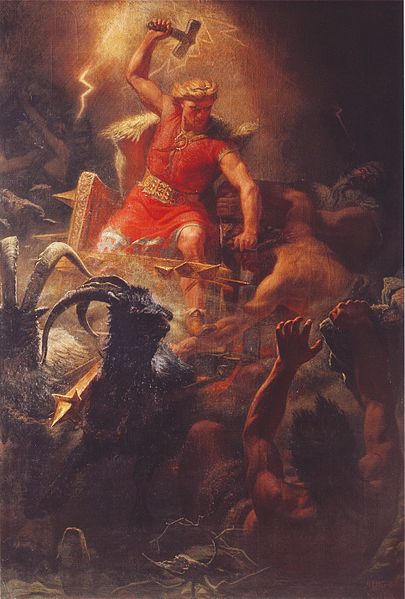
Perhaps the most iconic artifact associated with Thor is his hammer, Mjölnir. Crafted by the skilled dwarven brothers, Sindri (or Brokkr) and Brok, this hammer wasn’t just a symbol of Thor’s power; it was an extension of his will, a manifestation of thunder and force. Mjölnir had the unique ability to always return to Thor after being thrown and was a potent weapon against the giants, Thor’s perpetual adversaries.
Megingjörð – The Girdle of Strength
Another significant artifact Thor possessed was Megingjörð, the Girdle of Strength. When worn, this belt amplified Thor’s already formidable strength, making him nigh unstoppable. It was an essential accessory for Thor, especially during his epic battles against the giants and other formidable foes.
Járngreipr – The Iron Gloves
Thor’s ensemble was completed with Járngreipr, a pair of iron gloves. These weren’t just regular gloves, but gauntlets that allowed Thor to wield Mjölnir without harming himself, given the hammer’s immense power and energy. Together with Mjölnir and Megingjörð, these gloves made Thor one of the most formidable beings in Norse mythology.
Tanngrisnir and Tanngnjóstr – The Thundering Goats
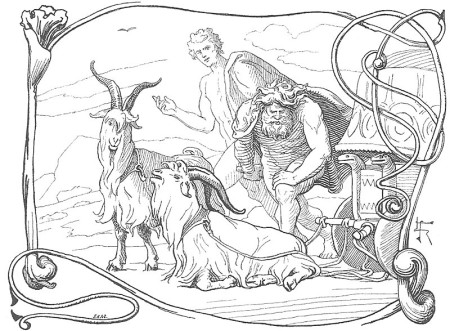
Adding a touch of the unusual to Thor’s iconography were his two goats, Tanngrisnir and Tanngnjóstr. These weren’t ordinary goats; they were magical creatures that pulled Thor’s chariot. Every evening, Thor could feast on them, and by the next morning, they would be restored to life, provided their bones remained intact. They symbolized regeneration, abundance, and Thor’s connection to the common man, who also relied on livestock for sustenance.
In essence, each symbol, artifact, or animal associated with Thor provided layers of depth to his character and his role in the cosmos. They were more than mere objects; they told tales of heroism, resilience, and the intricate bond between gods and mortals in the world of Norse mythology.
Symbols
During the Viking Age, the hammer became a popular motif; it was often fashioned into pendants, symbolizing protection and power. Moreover, engravings of Mjöllnir could be found on various objects ranging from rune stones to intricate jewelry and even on weapons. For the Norse people, carrying or depicting Mjölnir was not just an artistic choice, but also a profound statement of belief and identity.
Myths Involving Thor
The mythology surrounding Thor is extensive and multifaceted, offering a deep dive into his various exploits, interactions, and adventures. Here are some of the key myths where Thor is a central figure:
Battling the Midgard Serpent
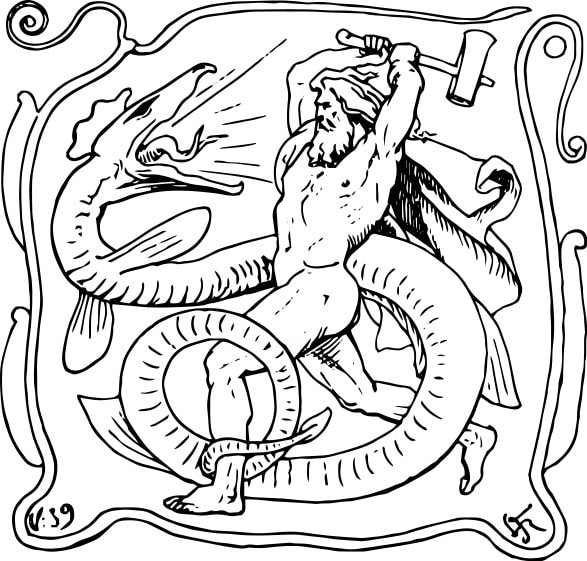
During a fishing expedition with the giant Hymir, Thor attempted to capture Jormungandr, the Midgard Serpent. Using an ox-head as bait, Thor hooked the monstrous serpent, and a fierce battle ensued. Although Thor managed to pull the serpent to the surface, Hymir, frightened, cut the fishing line, allowing Jormungandr to escape, ensuring their final confrontation during Ragnarök.
Duel with Hrungnir
Hrungnir, a formidable giant with a heart of stone, challenged Thor to a duel. In this intense showdown, Thor shattered Hrungnir’s stone shield with his mighty hammer, Mjölnir, before dispatching the giant with a crushing blow to his head. This victory solidified Thor’s reputation as a protector of the gods and humankind against the giants.
Journey to Útgarða-Loki’s Castle
On a quest to prove his strength, Thor, accompanied by Loki and two human companions, ventured into the castle of the giant Útgarða-Loki. Here, they were subjected to a series of deceptive challenges. Thor’s tasks included a drinking contest against an enchanted horn, a wrestling match with old age personified, and an attempt to lift the Midgard Serpent disguised as a cat. Although appearing to fail these challenges, Thor’s feats left a lasting impression on Útgarða-Loki, who later admitted his use of illusions to deceive the god.
Thrymskvida – Theft of Mjölnir and the Marriage Disguise
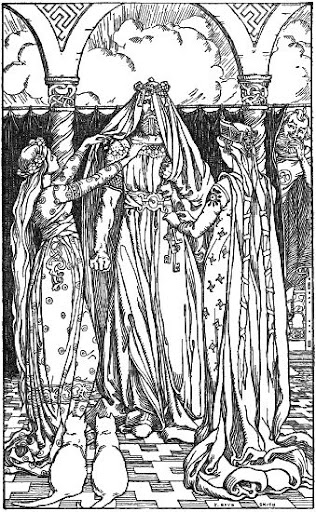
In one of the lighter-hearted tales, the giant Thrym stole Mjölnir and demanded the goddess Freyja as his bride in exchange. Devised as a plan to retrieve the hammer, Thor disguised himself as Freyja and attended the wedding feast. Once the hammer was revealed, Thor shed his disguise and unleashed his wrath upon Thrym and his kin.
Battle of Wits with Odin in Hárbarðsljóð
While journeying “from the east,” Thor encounters a ferryman named Hárbarðr, who is Odin in disguise. The two engage in a fierce exchange of insults, with Hárbarðr denying Thor passage and boasting about his own exploits. The poem unveils some of Thor’s adventures, including his confrontations with giants and his visits to various realms.
The Quest for a Brewing Cauldron in Hymiskviða
The gods’ quest for a cauldron to brew ale led Thor to the giant Hymir’s abode. After a series of challenges, including a fishing trip where Thor confronts Jormungand, Thor manages to obtain the cauldron. On their journey back, they are pursued by an army of many-headed giants. However Thor’s prowess with Mjölnir ensures their safe return.
In these tales, Thor’s character shines as a fearless warrior, a protector, and occasionally, a figure of humor. Through battles, confrontations, and even deceptive challenges, Thor’s narratives are integral to the Norse mythological framework. Often showcasing his might, wit, and indomitable spirit.
Alvíssmál: A Contest of Wisdom
In “Alvíssmál,” Thor engages in a battle of wits with the dwarf Alvíss (“All-Wise”). The dwarf seeks Thor’s daughter, Thrúd, in marriage, believing she’s been promised to him. To delay and ultimately prevent this union, Thor challenges Alvíss to prove his name’s worth, asking him to detail the names various beings use for universal phenomena, from the sun to the moon. As Alvíss showcases his vast knowledge, dawn approaches. Thor’s cunning becomes evident when the sunlight turns the dwarf to stone, ensuring Thrúd’s safety and demonstrating that Thor’s strength isn’t just physical.
Ragnarök: The Final Battle
At Ragnarök, the end of the world, Thor faces off against the great serpent Jörmungandr. In a climactic battle, Thor emerges victorious, slaying the massive beast. However, this victory comes at a cost. After taking only nine steps from the site of their clash, Thor succumbs to the serpent’s venom. This marks the god of thunder’s tragic demise amidst the larger fall of the gods. This final confrontation exemplifies Thor’s unyielding courage and determination, even in the face of inevitable doom.
Mentions of Thor
In the stories of Norse mythology, Thor stands as a prominent and influential figure. His myriad adventures, interactions, and exploits are detailed in various parts of both the Poetic Edda and the Prose Edda. Furthermore, he is frequently mentioned in the Heimskringla and other sagas as well.
Poetic Edda
Völuspá
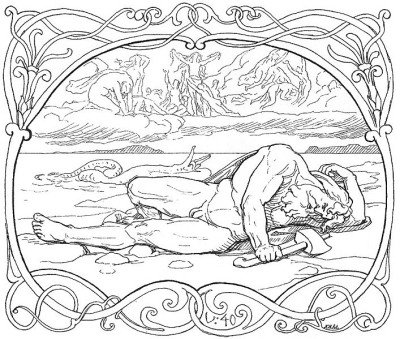
In Völuspá, a dead völva recounts the history of the universe and foretells the future to Odin in disguise. This includes the death of Thor during Ragnarök where he combats the great serpent and slays it. However, the aftermath sees Thor taking only nine steps before falling dead due to the serpent’s venom.
Quote:
“Then comes the mighty son of Hlôdyn: (Odin’s son goes with the monster to fight); Midgârd’s Veor in his rage will slay the worm. Nine feet will go Fiörgyn’s son, bowed by the serpent, who feared no foe. All men will their homes forsake.”
Hárbarðsljóð
Hárbarðsljóð showcases Thor’s encounter with a ferryman, Hárbarðr (Odin in disguise). The poem highlights a verbal duel between Thor and Hárbarðr, referencing various lore about the two gods.
Hymiskviða
Hymiskviða centers on Thor’s quest for a cauldron large enough to brew ale for the gods. The story involves Thor’s encounters with Hymir, his challenges, and his eventual success in procuring the cauldron.
Lokasenna
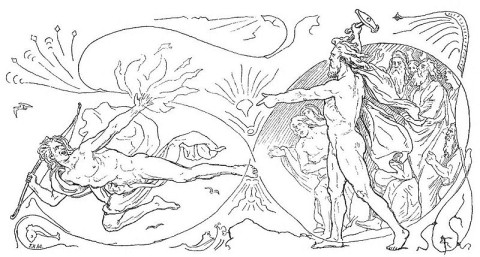
In Lokasenna, Loki disputes with the gods in Ægir’s hall. Though Thor is away, he eventually arrives, and a verbal conflict between Thor and Loki ensues, with Loki making several taunts and accusations.
Þrymskviða
Þrymskviða focuses on the theft of Thor’s hammer, Mjölnir. It delves into Thor’s efforts, with Loki’s assistance, to retrieve his stolen hammer. The highlight includes a comedic instance where Thor disguises himself as a bride.
Alvíssmál
Alvíssmál presents Thor’s efforts to protect his daughter from the dwarf Alvíss. Thor engages the dwarf in a long Q&A session about the cosmos. However, this turns out to be a ploy by Thor to delay the dwarf until daylight, which turns him into stone.
Prose Edda
Prologue
The Prologue of the Prose Edda serves as an introduction to Norse mythology and its pantheon. Thor is introduced as the powerful son of Odin and Earth. The Prologue portrays the gods in a more human, historical context, as ancient kings and warriors whose deeds were so grand they were later deified.
Gylfaginning
“Gylfaginning” or “The Tricking of Gylfi” contains some of the most famous tales of Norse mythology. Within it, Thor’s adventures are frequently discussed:
- The Journey to Utgard: This tale recounts Thor’s journey to the stronghold of the giants, Utgard, and his challenges against the giants there. For example, he wrestles with Elli, who personifies old age, and attempts to lift a cat which, unbeknownst to him, is actually the Midgard serpent, Jörmungandr, in disguise.
- The Theft of Mjölnir: The story tells of Thor waking up to find his hammer missing, which leads to a quest to retrieve it. To do so, he disguises himself as Freyja to trick the giant Thrym, who has taken the hammer.
Skáldskaparmál
“Skáldskaparmál” or “The Language of Poetry” delves into the poetic expressions and kennings used by skaldic poets. It contains numerous stories used to explain the origins of these poetic expressions, many involving Thor:
- Thor’s Duel with Hrungnir: This recounts the tale of the strongest of the giants, Hrungnir, and his challenge to duel with Thor. The resulting fight is explosive and showcases Thor’s might.
- Thorsdrapa: This poem, by Eilífr Goðrúnarson, provides a detailed account of Thor’s journey to the hall of the giant Geirröd. It highlights the various challenges Thor faces along the way, emphasizing his might and determination.
- Haustlöng: Composed by Tjodolfr of Hvinir, this poem focuses on two separate myths. The first one involving Thor, the second the gods Odin and Loki. The section about Thor describes his encounter and subsequent battle with the giant Hrungnir.
Háttatal
“Háttatal” is a demonstration of various poetic forms. It primarily showcases the intricacies of Old Norse poetics. However, there are mentions of Thor and his exploits within the various examples given.
Heimskringla
In Heimskringla, Thor or his statues appear in various sagas. For instance, in the Ynglinga saga, a euhemerized account describes Thor as a pagan priest stationed in Þrúðvangr (modern-day Sweden). There he is bestowed upon by Odin, a mighty chieftain from the east.
Frequently Asked Questions
Thor wielded control over thunder, lightning, and storms. With his hammer, Mjölnir, he could crush any adversary.
Thrym, a giant, once stole Mjölnir, leading to an exciting tale of its retrieval.
Tanngrisnir and Tanngnjóstr, Thor’s goats, pulled his chariot and were symbols of his power and connection to thunder.
Their relationship was complex; while they had adventures together, Loki’s mischief often exasperated Thor.
During Ragnarok, after slaying the Midgard Serpent, Thor succumbed to its venom.
Thor was the son of Odin, the Allfather, and Jord, the embodiment of Earth.
Gallery
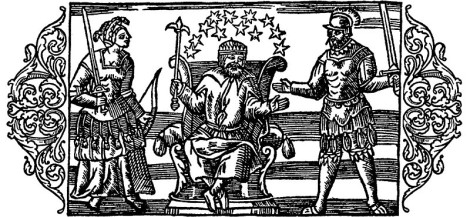 16th-century depiction of Norse gods from Olaus Magnus’s A Description of the Northern Peoples; from left to right, Frigg, Thor and Odin
16th-century depiction of Norse gods from Olaus Magnus’s A Description of the Northern Peoples; from left to right, Frigg, Thor and Odin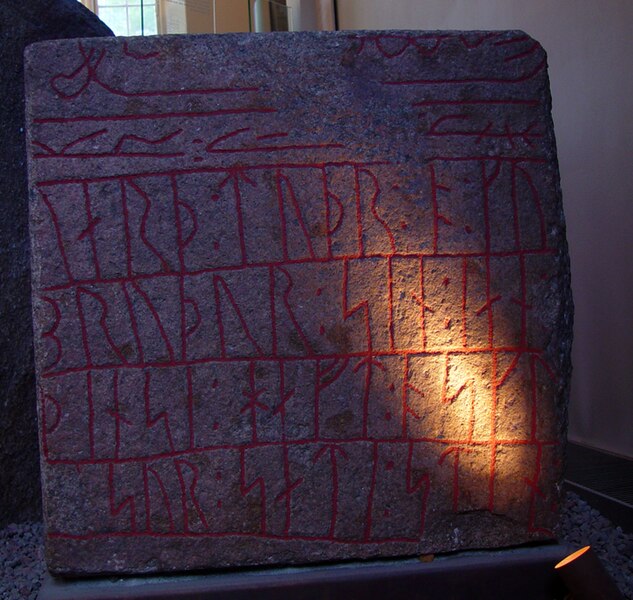 Runestone from Sønder Kirkeby, Falster, Denmark. Now housed at the National Museum of Denmark
Runestone from Sønder Kirkeby, Falster, Denmark. Now housed at the National Museum of Denmark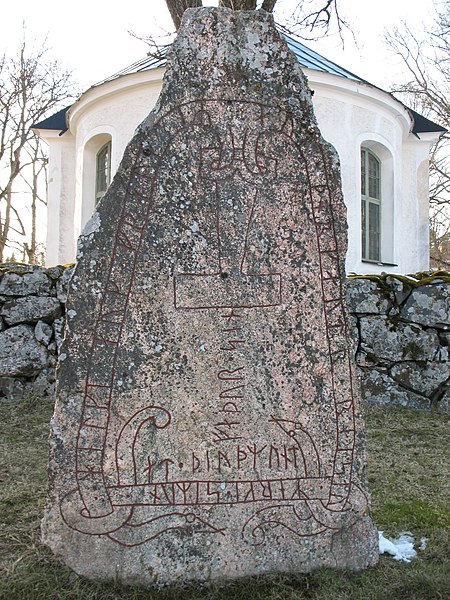 A runestone from Södermanland, Sweden bearing a depiction of Thor’s hammer
A runestone from Södermanland, Sweden bearing a depiction of Thor’s hammer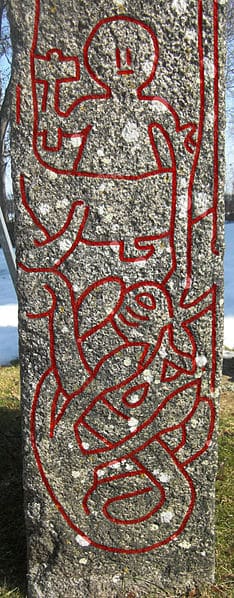 The Altuna stone from Sweden, one of four stones depicting Thor’s fishing trip
The Altuna stone from Sweden, one of four stones depicting Thor’s fishing trip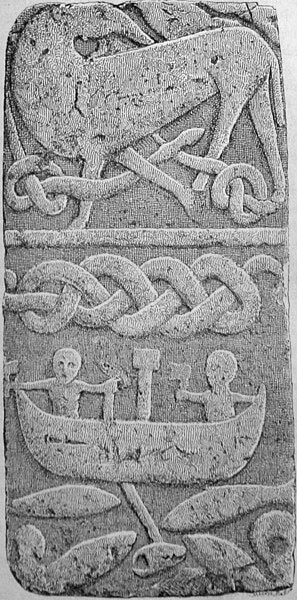 The Gosforth depiction, one of four stones depicting Thor’s fishing trip
The Gosforth depiction, one of four stones depicting Thor’s fishing trip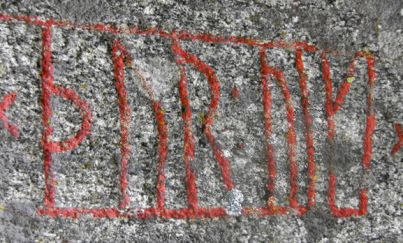 Runes (᛭ᚦᚢᚱ᛬ᚢᛁᚴᛁ᛭) × þur : uiki × on the Velanda Runestone, Sweden, meaning “may Þórr hallow”.
Runes (᛭ᚦᚢᚱ᛬ᚢᛁᚴᛁ᛭) × þur : uiki × on the Velanda Runestone, Sweden, meaning “may Þórr hallow”.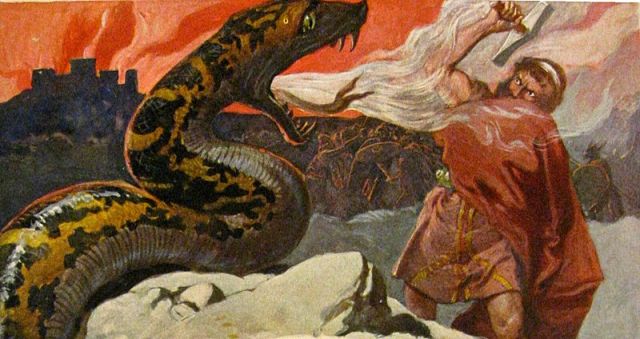 Thor and the Midgard Serpent (by Emil Doepler, 1905)
Thor and the Midgard Serpent (by Emil Doepler, 1905)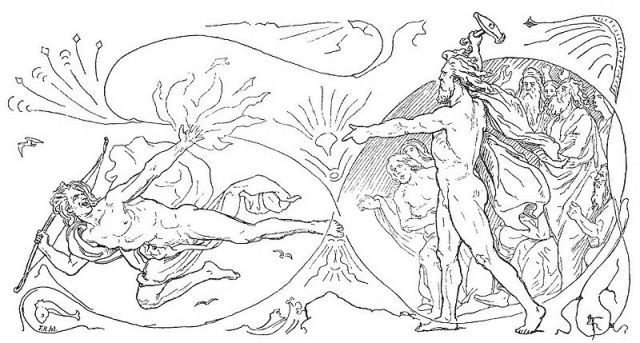 Thor raises his hammer as Loki leaves Ægir’s hall, by Frølich (1895)
Thor raises his hammer as Loki leaves Ægir’s hall, by Frølich (1895)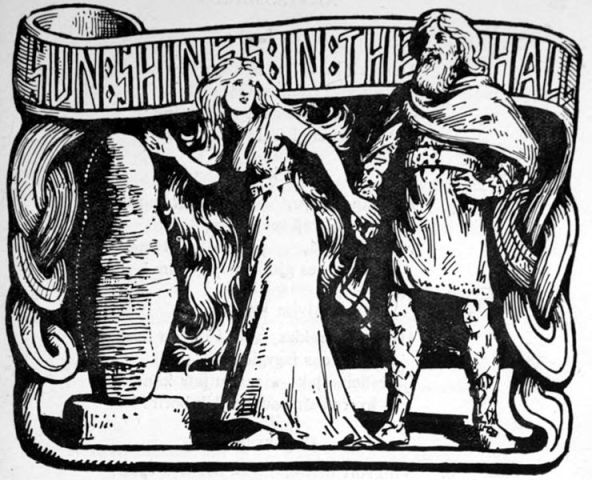 Sun Shines in the Hall (1908) by W.G. Collingwood: Thor clasps his daughter’s hand and chuckles at the “all-wise” dwarf, whom he has outwitted
Sun Shines in the Hall (1908) by W.G. Collingwood: Thor clasps his daughter’s hand and chuckles at the “all-wise” dwarf, whom he has outwitted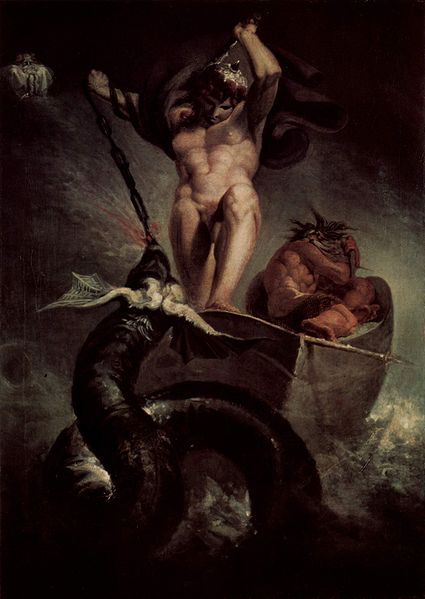 Thor Battering the Midgard Serpent (1790) by Henry Fuseli
Thor Battering the Midgard Serpent (1790) by Henry Fuseli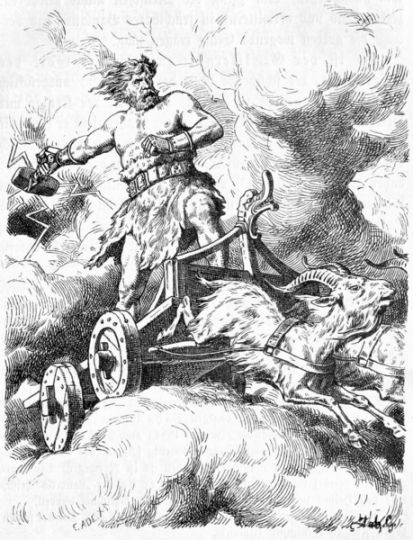 Thor on his wagon being pulled by the goats Tanngnjóstur and Tanngrisnir with the hammer Mjölnir in his hand.
Thor on his wagon being pulled by the goats Tanngnjóstur and Tanngrisnir with the hammer Mjölnir in his hand.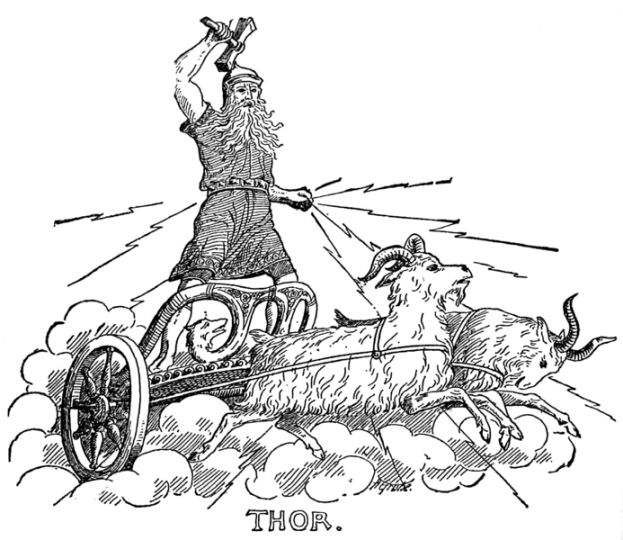 Thor on his chariot
Thor on his chariot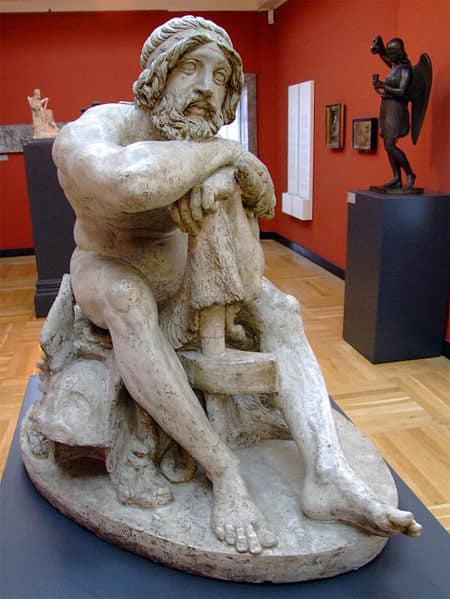 A photograph of “Thor” (1829) by H. E. Freund, housed at the Ny Carlsberg Glyptotek, Copenhagen, Denmark.
A photograph of “Thor” (1829) by H. E. Freund, housed at the Ny Carlsberg Glyptotek, Copenhagen, Denmark.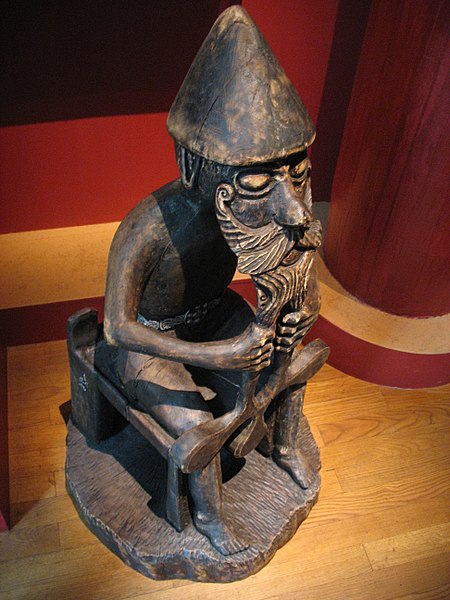 A reproduction in wood of an Icelandic original known as the Eyrarland statue depicting the Germanic war and thunder god Thor, displayed at the Swedish Army Museum.
A reproduction in wood of an Icelandic original known as the Eyrarland statue depicting the Germanic war and thunder god Thor, displayed at the Swedish Army Museum.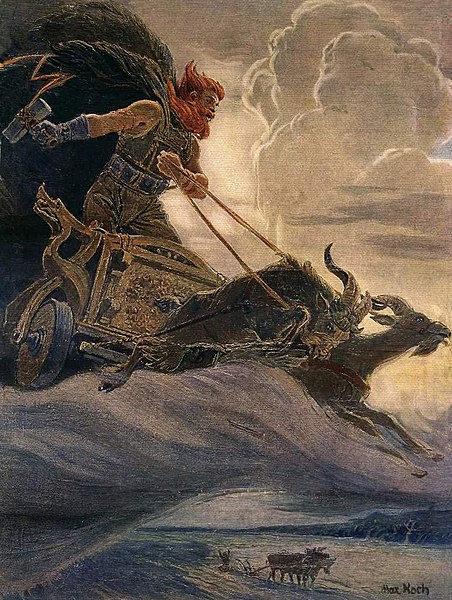 Thor on his chariot
Thor on his chariot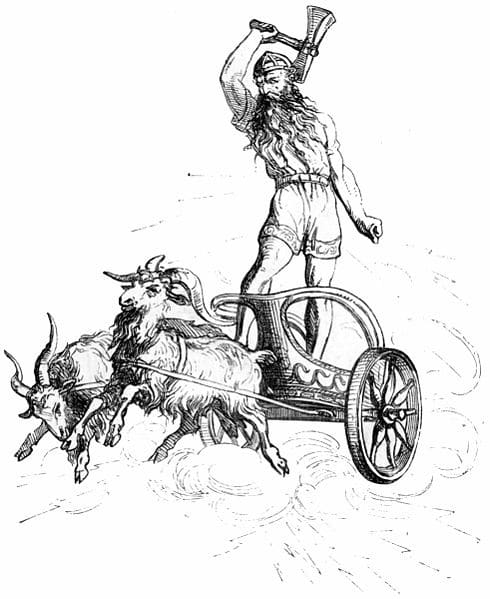 Thor with his chariot
Thor with his chariot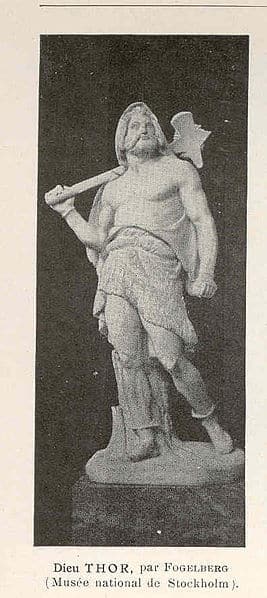 Thor Statue
Thor Statue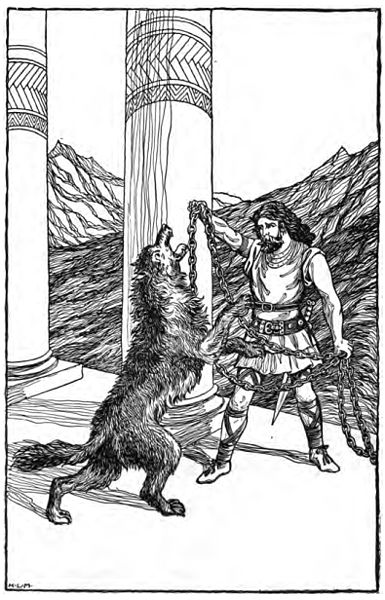 Thor Chaining Fenrir
Thor Chaining Fenrir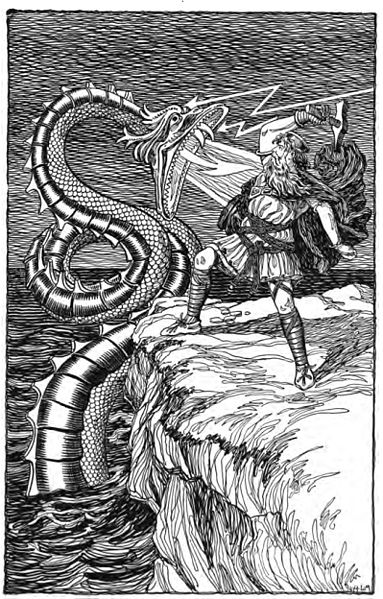 Thor Fighting the Serpent. Thor brandishes his hammer at Jörmungandr.
Thor Fighting the Serpent. Thor brandishes his hammer at Jörmungandr.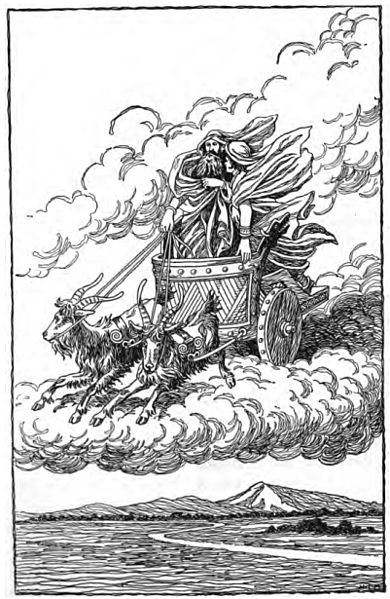 Thor & loki in chariot
Thor & loki in chariot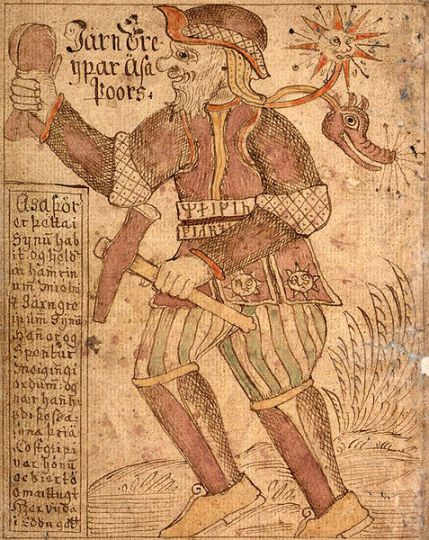 An illustration of the god Thor with his hammer Mjöllnir, from an Icelandic 18th century manuscript.
An illustration of the god Thor with his hammer Mjöllnir, from an Icelandic 18th century manuscript.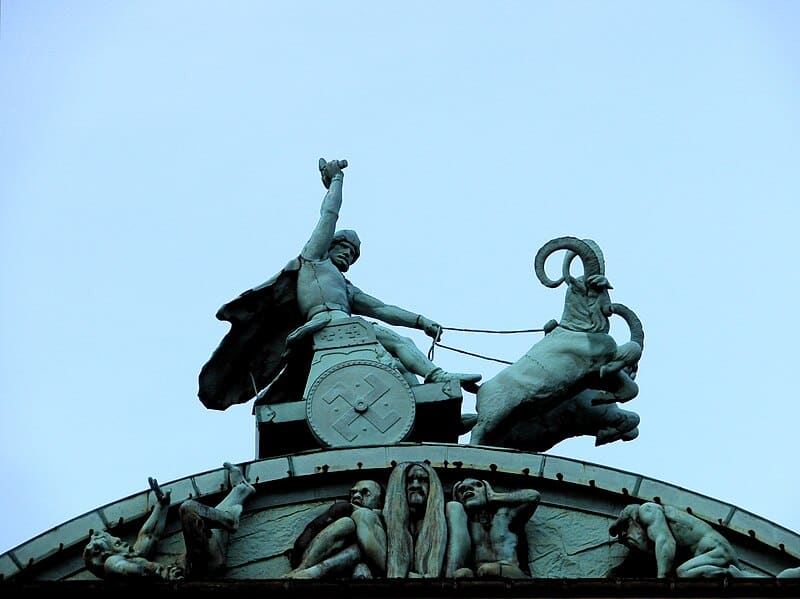 Thor drives his goats, Carl Bonnesen (1868-1933), on the roof of Carlsberg Bryghus, Copenhagen
Thor drives his goats, Carl Bonnesen (1868-1933), on the roof of Carlsberg Bryghus, Copenhagen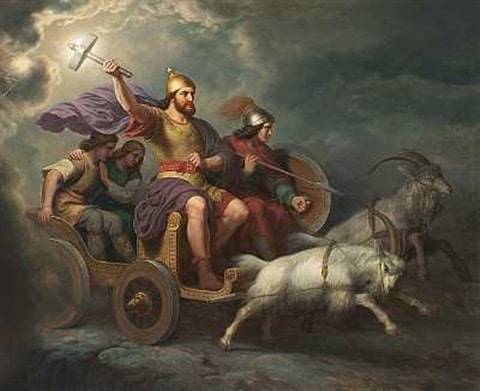 Thor goes on adventures with Asaloke, Roska and Tjalfe
Thor goes on adventures with Asaloke, Roska and Tjalfe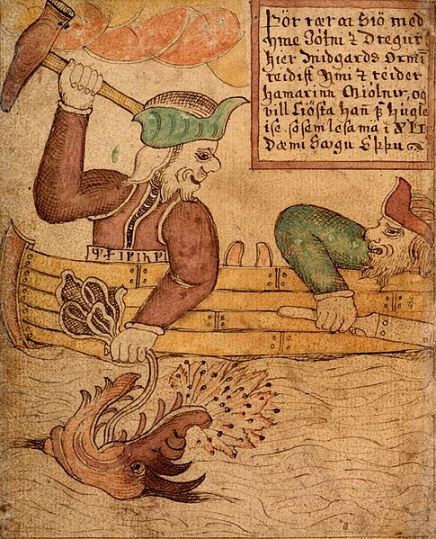 Thor and Hymir go fishing for the Midgard Serpent
Thor and Hymir go fishing for the Midgard Serpent
Play Fun Norse Quiz
Is this article making you even more curious about Norse gods and goddesses? You can satisfy your curiosity by playing a fun Norse mythology quiz. This way, you can test your knowledge about Norse gods and goddesses, as well as fill in some gaps. Good luck and have fun playing!
You might be interested in this fun game too! It reveals the parentage of Thor and other sons (and daughters) of Odin:
Don’t forget to try our other games as well!
Featured Image Credit: Emil Doepler, Public domain, via Wikimedia Commons
